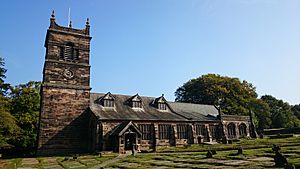St Mary's Church, Rostherne facts for kids
Quick facts for kids St Mary's Church, Rostherne |
|
|---|---|

St Mary's Church, Rostherne
|
|
| Lua error in Module:Location_map at line 420: attempt to index field 'wikibase' (a nil value). | |
| OS grid reference | SJ 743 837 |
| Location | Rostherne, Cheshire |
| Country | England |
| Denomination | Anglican |
| Website | St Mary, Rostherne |
| History | |
| Status | Parish church |
| Architecture | |
| Functional status | Active |
| Heritage designation | Grade I |
| Designated | 5 March 1959 |
| Architect(s) | John Rowson Sir Arthur Blomfield |
| Architectural type | Church |
| Style | Gothic, Neoclassical |
| Completed | 1888 |
| Specifications | |
| Materials | Sandstone Slate and lead roof |
| Administration | |
| Parish | Rostherne with Bollington |
| Deanery | Knutsford |
| Archdeaconry | Macclesfield |
| Diocese | Chester |
| Province | York |
St Mary's Church is a beautiful old church. It stands between the village of Rostherne and Rostherne Mere in Cheshire, England. This church is very important. It is listed as a Grade I historic building. This means it is one of the most special buildings in England! St Mary's is an active Anglican parish church. It is part of the Church of England. It serves the local community and is connected to Holy Trinity Church in Bollington.
Contents
The Church's Story Through Time
We don't know much about the very first days of St Mary's Church. There is no mention of it in the old Domesday Book. But a document from 1188 says a church was already built there. A tall steeple was added in 1533. In 1666, a message was carved on the tower. It asked for prayers for William Hardwick and his church members.
Sadly, the steeple fell down in November 1741. It had been getting weaker for many years. The fall also damaged the rest of the church. Between 1742 and 1744, a new tower was built. The damaged parts of the church were also rebuilt. The architect for this work was John Rowson.
Later, in 1888, the chancel (the area around the altar) and a small room called the north vestry were added. These parts were designed by Sir Arthur Blomfield. The south porch, which is like a covered entrance, was built around 1886. The church was fully restored in 1888. This was paid for by Wilbraham Egerton, 1st Earl Egerton. He wanted to remember his father, Baron Egerton.
Church Design and Features
The church and its tower are made from sandstone. The roof is covered with slate and lead. The tower is at the west end of the church. The main part of the church, called the nave, has four sections. It also has side aisles. The chancel has four sections and side chapels. There is also a vestry.
Outside the Church
The tower has three parts that get smaller as they go up. There is a clock on the south side. The openings for the bells look like Venetian windows. The top edge of the tower curves up at the corners. There are decorative vases on the corners and in the middle. It's unusual that the roof of the nave has dormer windows. These are windows that stick out from the roof. The church mostly looks like the Perpendicular style. But the north doorway and a window in the vestry have Decorated features.
Inside the Church
Inside, St Mary's Church mixes two styles: Gothic and classical. In the chancel, there is a stone statue of a knight lying down. This statue is very old, from around the time of King Henry III. It was found after the tower fell in 1741.
Another special memorial is for Charlotte Lucy Beatrix Egerton. She sadly drowned in Rostherne Mere in 1845, just before her wedding. This memorial was made by Richard Westmacott Jr. It shows Charlotte lying on her side with an angel leaning over her. There is also a monument on a wall for Samuel Egerton. It was made by John Bacon in 1792. This monument is made of white and grey marble. It has figures that stand out, showing Hope and Patience. John Bacon also made a monument for Jonas Langford Brooke, who passed away in 1784. You can find other memorials in the church for the Egerton family and other important local families.
The church organ was built in 1906 by A. Young. It was rebuilt between 1970 and 1979 by Sixsmith. The church has a set of six bells. The oldest bells are from 1630 and 1655. The other four bells were made by Rudhall of Gloucester in 1717, 1771, 1782, and 1785. The church's records of births, marriages, and deaths start in 1595. The records of the church leaders begin in 1673.
Things Around the Church
Outside the church, there is a lych gate from 1640. This is a covered gateway to the churchyard. It is considered one of the best examples in Cheshire. It even has a special closing system to keep animals out of the churchyard.
In the churchyard, you can also find a sundial from around 1730. It is also a Grade II listed historic item. Another Grade II listed item is the Simpson tomb. This tomb is made of ashlar sandstone and dates from around 1831. The churchyard also has the war graves of five soldiers. These soldiers died during World War I.
See also
- Grade I listed buildings in Cheshire East
- Grade I listed churches in Cheshire
- Listed buildings in Rostherne

